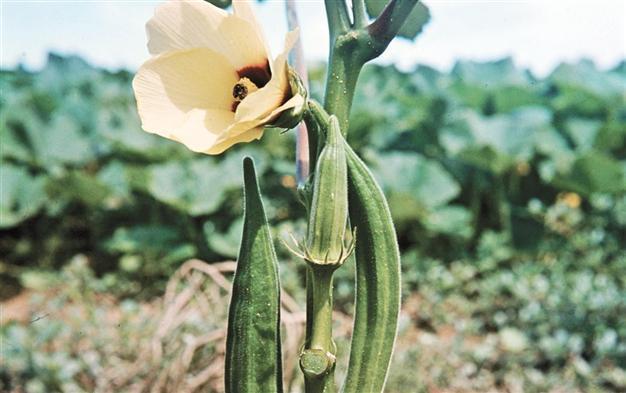African beauty
Aylin Öney Tan - aylinoneytan@yahoo.com

Okra’s culinary voyages always point to an African connection.
Okra is the hidden gem of Anatolian cuisine. Consumed both fresh and dried, it has deep roots in Ottoman culinary culture, marking the trade route from Africa to Asia Minor. It is believed to have originated from Ethiopia and Eastern Sudan and was cultivated along the Nile by the 12th century. Okra is called bamya in Turkish, coming from the Arabic word for the plant. The Egyptians and Moors also called it the same, so it may have traveled first to the Arabian Peninsula across the Red Sea or across the Mandab Strait and then made its way west toward to Egypt. It was probably introduced to Anatolia through trade with the port of Alexandria, probably via the port of Alanya, an important Seljuk city on the Anatolian Mediterranean coast.Okra was a much-loved vegetable even in the Seljuk period and since then it has been widespread and popular. It is peculiar that cities famous for its okra dishes are usually former important Seljuk or early Ottoman cities; such as Alanya, Konya, Amasya. In the Ottoman period there was even a sports team named after okra, bamyacılar-okra eaters, fierce competitors against the lahanacılar –cabbage eaters. The origin of the cabbage-okra rivalry has a funny history. These two very different vegetables have nothing in common, not even their harvest season, but one of the very first big martial sports games were held between two rivaling cities, one famous for its okra, the other for its cabbages. Amasya, known to be the home for the best okra, was competing against the cabbage growing Merzifon and the cheering crowd kept yelling the names of the vegetables to support their teams. It was just after the defeat of Ankara with Timur in the turn of 15th century, and the importance of cavalry became clear to the Ottomans. Sultan Mehmet I decided to train 200 cavalrymen each from Amasya and Merzifon and held challenging games to provoke competitiveness. Since then, okra and cabbage have been rivals in the field, if not on the table, very much like today’s football clubs. We do not know if the cavalrymen of Amasya had eaten their share of okra, but Amasya still grows good okra.
Okra’s culinary voyages always point to an African connection. The Ottoman dish of “aside” was of Ethiopian origin and was a favorite of African nannies who were a part of Ottoman elite families. As okra was a favorite among the African-origin people in the Ottoman world, it was again the slave trade that led okra into travelling from Africa to the New World and its spread to the southern states of America. The okra plant has two Latin names: one related to its fragrant seeds, Abelmoschus esculentus, derived from Arabic meaning “father of scents,” and the other Hibiscus esculentus, referring to the very pretty flowers of the hibiscus family. The former less used now, the latter more common, and perfectly in line with another name okra has: ladies’ fingers, due to its long pointed shape, perhaps because it resembled the elegant hands of Ethiopian ladies with long and gracious fingers. Bamya is a beauty to enjoy as a plant, and always a culinary delight, yet to be discovered by some picky eaters. Try okra with olive oil, if not convinced by the vegetable, try the hibiscus flower at least!
Bite of the week
Recipe of the week: Okra braised in olive oil (zeytinyağlı bamya) is bliss for summer lunches. Whatever one does, okra remains slippery, but if you cut the caps off in the correct way it will be less slimy. It is important to cut off the stem part with a small sharp knife, as if carving the cap off, without breaking the little glands that contain the mucilaginous sap. Clean 500 g small-sized okra, and arrange in layers in a pot in a pretty fashion. Sprinkle with 2 teaspoons sugar and 1-teaspoon salt. Slice cross-wise thickly 1 big onion, and place the onion slices over the okra, peel and cut in half one big ripe tomato. Place cut side down on the okra. Add ½ glass extra virgin olive oil and half fill the pot with water. Cover and braise slowly until very tender and all the cooking liquid is reduced down to a sauce-like consistency. Let cool in the pot, discard onion slices, and turn onto a serving plate. Serve at room temperature or cold.
Cork of The Week: Crimson colored hibiscus flowers is made into a lovely herbal tea known also as Karkade. It is different than the pale okra flower, but of the same family. It is believed to lower hypertension, and can be drunk both hot and cold. You can make your own cold tea by simply steeping dried hibiscus flowers in water or you can make your own wild hibiscus flowers in syrup to enliven your cocktails. Boil equal parts of sugar and water, and just add plenty of dried flowers, use the syrup instead of simple sugar syrup or sweet & sour mix in cocktails or drop one flower in the cocktail glass.












